Deconstructing the CDC's Position on Vaccinating COVID-Recovered Persons
A confusing "brief" by the CDC builds the evidence for accepting natural immunity, and then illogically concludes the opposite.
On October 29th 2021, shortly after releasing this MMWR study, the CDC (finally) released a “Brief”, to formally state its position on natural immunity against SARS-CoV-2 infection. The “brief” presents as an intellectually acrobatic, self-contradictory statement that essentially presents clinical data significantly favorable to the protection afforded by natural immunity — but then counters only with its own internally formulated studies: the now famous “KY” and the recent MMWR study that we will refer to as the “Hospital” study. They still inexplicably conclude in the Executive Summary:
“Substantial immunologic evidence and a growing body of epidemiologic evidence indicate that vaccination after infection significantly enhances protection and further reduces risk of reinfection, which lays the foundation for CDC recommendations.”
This article will systematically appraise the statements and arguments made in the “Brief”. What should become apparent is the intellectual acrobatics (or unfortunate ineptitude) the CDC authors go through to evade the external and mounting clinical evidence in favor of natural immunity. Tactics include selective presentation of data from particular studies, omission of countervailing data from the same studies, outright omission of germane studies entirely, logically fallacious comparisons, and misapplication of studies to the pertinent questions. Finally, they contradict themselves across various sections of the brief, perhaps hoping the reader will simply forget what they read earlier.
If these tactics are a generalization of their overall attitude towards public health analysis, transparency and communication, significant red flags need to be raised. We, and our children, deserve better from our public officials, particularly in the area of public health.
We will go through the brief, section by section. We will skip over the “Executive Summary”, and discuss the overall conclusion at the end.
”Background”
The “Background” section sets the frame of mind of the CDC - that nearly 1/2 of the the previously infected population remains unvaccinated. Not much to dispute here, as it sounds reasonable that many previously infected (PI) persons would be more vaccine hesitant — with good reason. The “Brief” also states that both infection and vaccination “initially confers high levels of protection” against COVID-19 illness. Again, no dispute — but their emphasis on “initially” is notable, as it implies some longer-term differentiation (there is, but its not in favor of vaccination). We will get to that later.
“Immune Response to Infection and Vaccination”
This section is the most well developed section of the entire brief, perseverating on a number of immunological studies, investigating relative neutralizing levels between vaccination and infection. For the most part, this discussion is not clinically germane. In vitro studies may be insightful on the science, but not a replacement for actual clinical outcome studies (which are addressed later).
Nevertheless, the authors acknowledge a “high-degree” of correlation between neutralizing antibodies and overall decrease of infection risk,, with 20% and 3% of MEAN CONVALESCENT (e.g. “previously infected”) levels correlating with 50% infection and hospitalization risk, respectively. This is favorable for PI persons, because greater levels of antibodies (say 50%) would lead to significant protection from natural immunity.
But, subsequently, they backtrack and state that antibody levels only provide a “partial” picture of an indivdual’s state of immunity, and therefore it cannot be used to inform on an individual’s risk. But if so, why does Pfizer’s 5-11 yo EUA application depend on antibody responses (e.g. “immunobridging”) to convince on efficacy? Seemingly, it seems that the CDC (and FDA’s VRBPAC) want to have it both ways: rely on antibody science when convenient for approval purposes on the masses (millions of children), but dismiss it for a person’s individual use. This is, simply put , not intellectually consistent.
The CDC’s next argument, is that there is no “standardized” approach, and a large variation in antibody responses in persons — and therefore, they suggest, that vaccination is the only way to achieve a standardized response. First, personal physicians (if empowered to do so) can interpret nuanced tests on an individual basis — we do so all the time! A CDC policy of clinical “equipoise” would be welcomed by the 50% of previously infected unvaccinated persons. Second, actual clinical outcome data (rather than laboratory studies) will be more instructive on risk (which physicians can also interpret.
Searches of the public medical databases find abundant immunological studies on SARS-CoV-2 response, with widely varying conclusions. Especially with laboratory studies, the “devil is in the detail” — and conclusions are only limited to the assumptions of the studies which are never discussed. Here, the CDC authors are simply selecting the laboratory studies that are favorable to their argument, but not appraising the countering studies out there. Thus, this is not a complete scientific argument.
To summarize, the “Brief’s” authors here try to make an argument of variability in immune response to SARS-CoV-2 infection based on selective sources of laboratory studies. They neglect, however, the ability of a person’s physician to wade through imperfect data and apply it to individual circumstances. Nevertheless, the granular details of immune responses are less pertinent than clinical outcome studies — which is the proof in the pudding.
“Duration of Immune Protection from Vaccination”
This is where it starts to get interesting. In this section, the authors try to quantify the degree of protection from natural immunity alone, without comparison to COVID-19 vaccination. They cite 5 studies, that collectively found a relative risk reduction (RR, comparable to “vaccine efficacy”) of 80-93%, AND, even higher (89-93%) if the person was proven serologically positive. Moreover, none of these studies found a decline over 7-12 months of the study. These RR numbers, comparable to the mRNA VEs (and superior to J&J) strongly support the notion of at least equivalency of natural and vaccinated immunity. The CDC authors, of course, do not mention this comparison to vaccine efficacy.
Subsequently, the authors lament that “all but two of these studies were retrospective” (meaning two were prospective!) and go through various biases the studies may have had (which is humorous, given their own flawed MMWR “KY” and “Hospital” studies, which they do not similarly appraise). They state that if SARS-CoV-2 is like other seasonal coronaviruses, then 50% protection would last for 1-2 years, which may be more durable that vaccination protection (hence, the booster discussion). Again, we don’t have vaccine data extending out 1-2 years that would suggest it would provide any more durable response. This tactic of claiming a potential fault of “natural immunity”, without providing positive proof that vaccination is superior in the same regard— is misleading.
Finally, the authors dive into variants of concern, or “VOCs” — with these 5 studies focused primarily on the Alpha phase of the pandemic. They then state there is “evidence that protection may decrease” with other variants "“as discussed below” — but as we will discuss, they show studies in which natural immunity is superior with the Delta virus! Its a dizzying internal contradiction!
“Impact of Variants on Infection- and Vaccine-induced Immunity”
Apparently in this section, they intend qualify their above statement (in the previous section) about natural immunity decreasing with the Delta variant. However, the first line of this section states that this decrease may occur with “prior infection or vaccination.” So, they are acknowledging that a decrease may occur in both natural and vaccinated immunity — but in the prior section, they implied that only “[natural] protection may decrease in the setting of more transmissible VOC”.Further, they base this claim only laboratory evidence, not any clinical outcomes-based evidence.
In the last paragraph of this section, they then state “Decreased neutralization [of natural immunity] against Delta parallels reduced vaccine effectiveness against infection, but effectiveness remains high against hospitalization or severe disease.” In other words, they are implying that natural immunity protection declines against hospitalizations and severe disease (without presenting any supporting evidence), but vaccine effectiveness is retained (based on their evidence). This rhetorical trick should fool nobody. In fact, there is some evidence from the “Israeli” study that natural immunity is more protective against severe “Delta” disease, as well. Why exclude countering data?
In direct studies of natural immunity versus vaccination (as we will see later), natural immunity performs better, in many instances, against the Delta variant (contradicting their argument that natural immunity is insufficient against variants). But, maybe they just hope the reader may not read that far (or even beyond the “Executive Summary”).
“Comparison of Infection- and Vaccine-induced Immune Responses”
In this, and the next section, the authors consider two important but independent questions. First (considered here), is how does natural and vaccinated immunity directly compare? Second (next section), is how effective is vaccination in previously infected persons, regardless of initial protection. This first question, the direct comparison of natural and vaccinated immunity, is politically pertinent — because it forms the clinical basis of the CDC’s argument that natural immunity is not sufficient for purposes of civic “mandates”.
In the first paragraph, they cite a “systematic review and metanalysis” that found “no significant in the overall level of protection” conferred by natural or vaccinated immunity. This is correct— it is based on a paper that I (along with co-authors Ralph Rahme and Hooman Noorchahsm) wrote, and recently published after peer-review. They qualify the study by saying that the mRNA vaccine trials showed higher protection than natural immunity — which is true, except these findings did not reach statistical significance.
The CDC authors also completely neglect the J&J trial reviewed in my paper, which did find a statistically significant advantage to natural immunity. (Neglecting J&J has become a common theme with the CDC now — see the MMWR “Hospital” study). But, For purposes of “mandate” politics, it is important not to neglect the J&J vaccine. If this vaccine is being used to satisfy any mandate, then why would one not accept superior natural immunity to do the same? There is no conscious treatment of this apparent omission or contradiction.
To counter our systematic review and metanalysis, the CDC authors then discuss their MMWR “Hospital” study — coincidentally released the same day as this brief. How convenient ?!?!? This study, of course, is significantly flawed — as I describe in this Twitter thread, with another appraisal by Harvard biostatistician, Dr. Martin Kuldorff, here.
To summarize the critique, the MMWR author’s design a cross-sectional study of hospitalized patients, using tortuous definitions and exclusion criterias, to define a population of ~7,300 persons with COVID-like illnesses (~6,300 fully vaccinated,~1,000 previously infected) — from an initial eligible population of 200,000 patients (an exclusion percentage of 96.5%%). A discerning look at the study populations show a stunning mismatch of measurable and immeasurable characteristics. Then they find an infection rate of 9% in the previously infected versus 5% in the fully vaccinated, and a crude odds ratio of 1.77 (not explicitly published). However, by applying a number of opaque statistical corrections, they get to an odds ratio of 5.5x, which happens to be the top-line result that is deployed to various media. This tripling of an odds ratio is not an “adjustment” - it is the desired result. This MMWR paper happens to be the only refutation they can come up with for this question.
(N.B. The CDC authors misrepresent their own paper, too. They state the data is taken from a network of 187 hospitals. This is in fact, a misrepresentation. While, the whole data network may represent 187 hospitals, the study pulls from only 7 hospitals, and 53% of the vaccinated subjects came from only 1 hospital. )
Next, they finally consider longitudinal data from the UK’s Office of National Statistics (A “longitudinal observational” study is a more direct way of studying the question), and found that full vaccination provided better protection for the Alpha variant (79 vs. 65%), but natural immunity was better protection against the Delta variant (67 vs. 71%, except they cleverly call this “equivalent” when its not in their favor) But, wait! Didn’t the CDC authors state earlier that natural immunity protection was not sufficient for “VOCs”? They did! So, they literally provide evidence that contradicts their earlier declaration.
By the way, they neglect discussing the famous Gazit Israeli study that also directly asks the question of protection in natural vs. vaccinated immunity - that found 6-27x odds in favor of natural immunity, during the Delta phase (they later cite this study when the conclusion favors their position). They also neglect two Indian studies Satwik et al. and Murugesan et al., that demonstrated natural immunity superiority over vaccinated immunity, during the Delta phase — the latter of which they again later cite when convenient to their position!
So ultimately, the only study they have that strongly favors their position on this question is the flawed and conveniently (same-day) published MMWR “Hospital” study. And, they neglect direct discussion of the Gazit study, which is probably the most damning evidence to their position, yet. This selective attention/neglect they give to pieces of evidence based upon their desired narrative, should be of concern to our citizenry.
“Vaccine-induced Immune Responses after Previous Infection”
This final section attempts to persuade the reader that vaccination, provides and additional, substantial benefit to the previously infected. They state, “there is substantial immunologic and epidemiological evidence that vaccination following infection further increases protection . . . among those who have been previously infected.” Again, they bring up a number of laboratory studies that support their position. They fail to bring up other laboratory studies that do not (the COVID-19 antibody literature is quite large, and easy to find a result you agree with). Clinical outcome studies are the only ones that should matter in practice.
In review of the epidemiological literature, they begin with the Cleveland Clinic health care worker study (Shrestha et al.), which looked at roughly 2,600 individuals, a subset of which were previously infected and either vaccinated or unvaccinated. Not a single person with previous infection, either vaccinated or unvaccinated, was reinfected in this study. However, persons within this study that were vaccinated without previous infection DID get reinfected (0.9%). The CDC’s “brief” authors conveniently left his out of the discussion one section earlier, of course.
Next, they bring up their own MMWR “KY” study, which has garnered a lot of press and attention. In this study, the conclusion is that previously infected unvaccinated persons have a 2.34x chance of reinfection, compared to previously infected vaccinated persons. This study was performed on only a short 2 month follow-up period. And, what the study authors failed to disclose (among a number of other flaws and limitations) is that the absolute risk of infection (246 out of 275,000 eliglible) was extremely small (0.09%), with no discussion on severity of illness. Once again, another CDC sponsored MMWR article to the rescue of their fledgling narrative! How convenient!
Next, in order to bring up some independent credibility to their argument, they cite other studies. First, they cite the Israeli Gazit study — yes, the same one they neglected in an earlier section because it devastated their desired conclusion. They tout the result of “greater protection from subsequent infection than vaccination alone”, but decline to actually to describe the numbers. In this study, the authors found a 0.53x risk of reinfection in unvaccinated PIs, compared to vaccinated counterparts. However, on an absolute basis — this equated to preventing 17 infections out of 14,000 persons, that is 0.1% of previously infected persons.
Similarly, they bring up the recently published Indian study, as evidence that their position of vaccinating the naturally immune is justified. However, they only state qualitative conclusion of this paper that they agree with. This Indian study actually found an 86% vs a 91.1% difference in protection between unvaccinated and vaccinated PI persons — and this difference was statistically insignificant. Furthermore, overall vaccine efficacy for COVID-naive persons in this study was only 31.8%! In other words, previously infected persons, regardless of vaccination, had significantly higher levels of protection than vaccinated never infected persons! No wonder this paper was avoided in the previous section.
To add insult to injury, this Indian study does not even utilize the U.S. based vaccines (Pfizer, Moderna, or J&J), it uses the ChAdOx1 nCoV-19 vaccine only available overseas. Why did the CDC authors bring up this study, but essentially neglect the J&J everywhere else in their brief ? This is the dangerous tactic of cherry-picking,
To end the section, they return to our paper , concluding across 7 studies that there was a “modest but significant” increase in protection with vaccination in the previously infected. This is true, but they failed to describe modesty: the net decrease was about 0.005 infections/person-year — or in other words, you need to vaccinate ~200 PI persons to save one infection. This is an incredibly small benefit, and the point of our paper. But note again, how they only pulled the conclusion they wanted from the paper, while neglecting the rest of the analysis.
There is also evidence, that they neglect entirely. Recently, the NEJM published a Pfizer-funded study , that was a 6 month continuation of its pivotal vaccine efficacy trial. In that trial, the previously infected (serologically positive) found only a 19.2% vaccine efficacy (by the way, this result is not mentioned in the NEJM paper, you have to dig deep to the last pages of the Supplementary Appendix to pull out this gem). In another Moderna-funded “real life” trial, the authors only found an 8-33% vaccine efficacy in those with a history of previous infection. These are major clinical trials and observations, industry-sponsored, that the CDC decided to neglect in their “Brief”. I would hope this is only a simple oversight, and not a deliberate omission.
Summary
I bring this appraisal up as a concerned citizen, fearful that political endpoints have now bypassed scientific reason at the CDC. This “Brief,” is but one example of the desired narrative driving the scientific process, rather than vice versa. And, the CDC now holds an arrogant and delusional belief that their non-peer-reviewed and technically flawed studies published in the MMWR, somehow hold greater scientific weight then now over 100 research studies supporting natural immunity to COVID-19.
This posture is a dangerous path for American public health — not only in its questionable recommendations, but also in the future mistrust they will foster with such chicanery.
To restate the CDC’s Executive Summary conclusion within this brief:
“Substantial immunologic evidence and a growing body of epidemiologic evidence indicate that vaccination after infection significantly enhances protection and further reduces risk of reinfection, which lays the foundation for CDC recommendations.”
After reading this, I hope it is clear that there is simply not a “growing body of epidemiological evidence” to support the claim of “significantly” enhanced protection or risk reduction, in PI persons. To the contrary, the external clinical studies strongly refute any significant difference between natural and vaccinated immunity, and only support a very marginal incremental benefit. In fact, the only studies that support this summary are the CDC’s own MMWR studies (with significant design and statistical flaws), constructed specifically to support their narrative. This summary statement is an insult to any person who invests intellectual effort into reading the entirety of this “Brief” , and should put into question the CDC’s mission: to “conduct critical science” that “saves lives and protects people.”
Whether we like it or not, the position of the CDC holds significant weight with other organizations and legal venues. Public and privately enforced mandates are typically justified by the CDC’s position, and there is fear in these organizations to counter CDC dogma. Therefore, we should have every level of confidence that the CDC is objectively and systematically evaluating data and their recommendations. Sadly, the intellectual acrobatics and evasive tactics used in this “Brief” do not suggest such confidence.
How we have gotten to this position? I do believe that there are many well-intentioned persons with long careers of service within the CDC. I am also aware of a culture that may lack “psychological safety” — good scientists with good intentions, who simply want to maintain their goodwill and upward mobility, and therefore, avoid challenging the regime. This culture needs to change, with change starting at the top.
Thank you for reading this. As always, I am open to comments/corrections and concerns.
[DISCLAIMER: This article represents my opinion only, and not of any organization I am affiliated with. It based upon best efforts to compile and analyze the data and evidence. The intended use is for policy and public discussion purposes only. It is not a substitute for advice from a personal physician. Please consult your personal physician for health advice.]

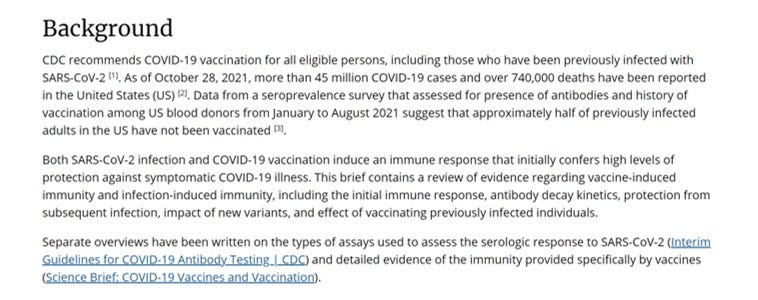

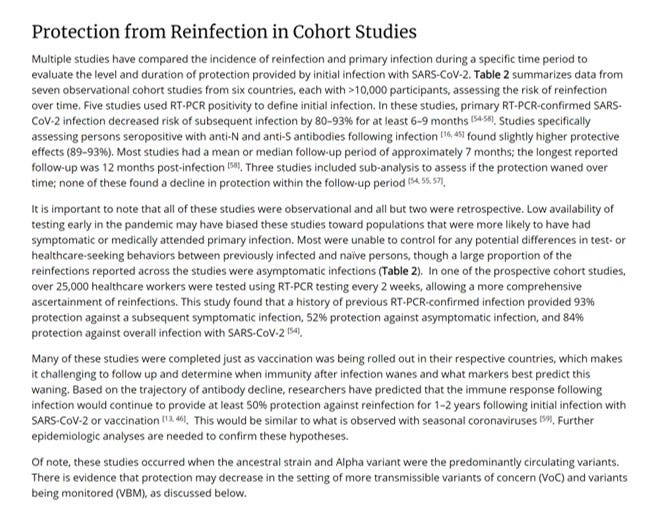
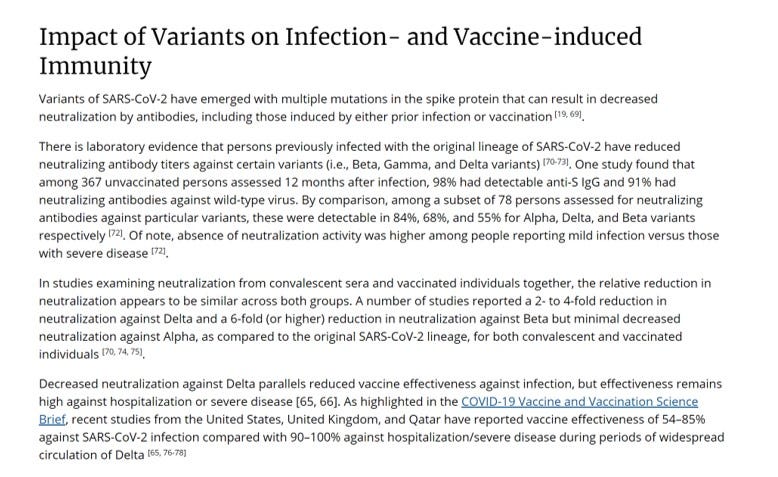
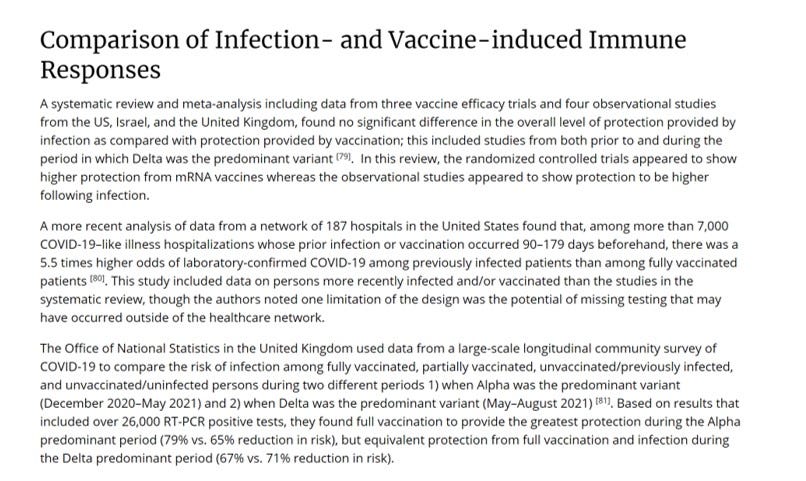
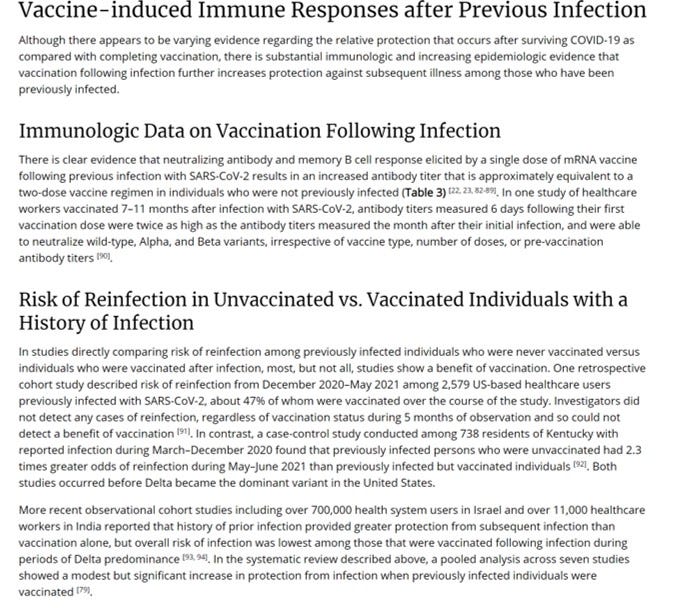

Thank you for this analysis. I am so exhausted from trying to make sense of things, as a person not trained in science or any of this. Yet it feels as though I have to try, as so many of the people (scientists, doctors) who are meant to be objective and who are the so-called experts appear to have gone awol down a rabbit-hole of fear, denial and irrationality. It doesn't take an expert, though, to see that things aren't stacking up, and that there are massive forces of coercion - not guided by science or medicine - at play. Thank goodness that there are still some who are unbending and courageous enough to speak up, such as yourself and other shining lights out there. The Kulldorffs, Bhattacharyas, McCulloughs, Makarys, Kheriatys, amongst others. History will vindicate them. But History takes time - and those of us in the present are suffering. I only wish that the rest of the experts would stop hiding behind their walls of "psychological safety" and speak up, too. Loudly and soon. Because those of us who have already been through the valley of covid and come out the other side are being thrown to the wolves, with precious little to protect us. We are losing our jobs, what's left of our own psychological safety, our health, our autonomy, our agency. It is a time of great peril. We really need you, the torch-carriers of science and rationality and the true carers of the sick and holders of the Hippocratic Oath, to defend your turf from the corroding effects of power and money and governmental influence - and to speak the truth. To maintain your objectivity. To ask the right questions. To seek out the correct answers. And, at the end of the day, to speak up! Please, please don't flinch from this.
The KY study has another huge flaw. As a nurse working a Covid unit, we all know that people test positive for weeks, and occasionally months after having Covid. In this study Covid reinfection is not clearly defined as having both symptoms and a positive PCR test, but can be 1 or the other. Another early study showed rate of reinfection goes down substantially after 3 months… hmmm - could it be because people aren’t still testing positive 3 months post infection??